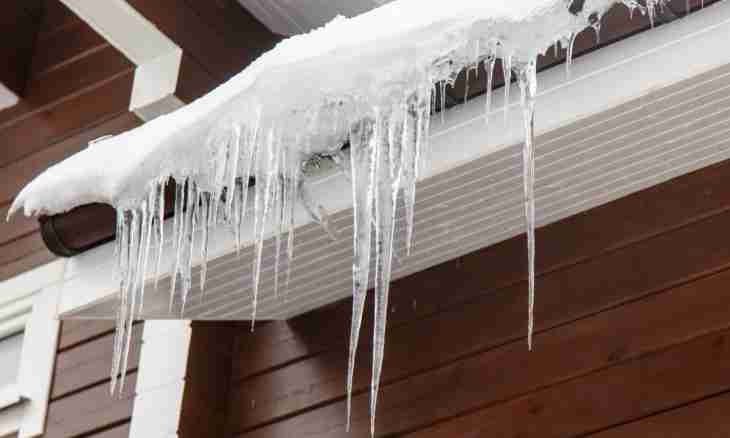Icicles on roofs usually appear at the beginning of spring. In some regions with sea climate they decorate roofs all winter, sometimes growing to such sizes that become serious danger to pedestrians. Speed of formation of icicles, their size and a form depend on several factors.
Why there are icicles
Icicles are formed when the difference of daytime and night time temperatures becomes considerable. In March days already considerably warms the sun, snow on roofs begins to thaw. Water flows down on a slope, and the droplet is on the edge formed. If it large and heavy, then, most likely, falls at once. The droplet less than 5 mm in the diameter remains on the edge of a roof.
There comes evening, air temperature goes down to zero and below, water freezes. The drop does not manage to come off and stiffens in that situation in which it was overtaken by a frost. In the morning temperature increases again. The stiffened drop thaws slightly more slowly, than snow in the middle of a roof so still the small droplet, or perhaps and not one manages to join it. There is a small icicle which begins to grow gradually.
Happens that icicles appear also in the winter, when there is no thaw. It happens because the roof can be warmed up not only outside, but also from within – the systems of steam heating or furnaces. The roof gets warm, snow thaws, water flows down to edges and freezes because temperature on eaves is much lower, than on the central sites of a roof. Ice which does not allow water to flow down is formed. The thermal insulation is worse, the more water flows down to edges and the icicles will be larger.
Large icicles constitute danger to pedestrians and cars therefore it is very important to warm roofs well.
Big and small icicles
Long ago it is noticed that in the seaside countries of an icicle are almost not formed. There is nothing surprising in it. For example, in the Baltic countries long since built houses with sharp high tile roofs. Snow does not linger on them, so, both does not thaw, and does not flow down streams. If a corner of a slope less than 40 °, icicles are formed much more intensively. Also material of which the roof is made plays a role. The smooth surface of a high roof does not allow snow to be late.
One of means of fight against large icicles - timely cleaning of snow from roofs.
Icicle form
Having considered in the spring several icicles, you can make sure that some of them absolutely smooth, and others have grooves. It especially distinctly is noticeable on large icicles. The form of an icicle depends on composition of water. The distilled water gives absolutely smooth surface as it contains no salts. Than more concentration of salt, especially grooves will be distinct, but at the same time the icicle keeps conical shape. However there comes the moment when the amount of salt reaches a certain limit, and then the icicle can get the most bizzare shape. It is possible to determine by this sign, for example, snow in your city is how polluted by salts.

